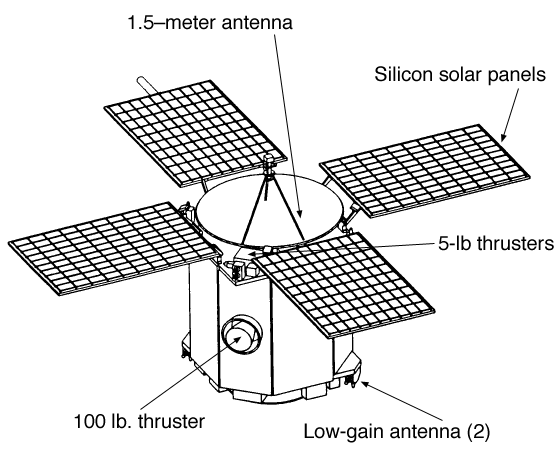Near Earth Asteroid Rendezvous (NEAR) Mission and Instrument Description
Mission Summary
The Near Earth Asteroid Rendezvous (NEAR) mission is the first launch in the Discovery Program, a NASA initiative for small planetary missions with a maximum 3-year development cycle and a cost capped at $150 million for construction, launch, and 30 days of operation. The NEAR mission is managed by the Johns Hopkins University Applied Physics Laboratory in Laurel, Maryland.
As the first spacecraft to orbit an asteroid, the NEAR mission promises to answer fundamental questions about the nature and origin of near-Earth objects, such as the numerous asteroids and comets in the vicinity of Earth's orbit.
These objects are of interest for several reasons. First, they are the primary source of large bodies that collide with Earth, greatly influencing the evolution of the atmosphere and life on Earth. An asteroid collision with Earth was likely responsible for the mass extinction at the end of the Cretaceous period, and another impact in 1908 destroyed thousands of square kilometers of forest near Tunguska, Siberia.
In addition, clues to the nature of early solar system processes and conditions are preserved in various forms on small bodies like asteroids, comets, and meteorites (so-called primitive bodies). These records have been altered or destroyed on large, planet-sized bodies by processes of planetary evolution.
The near-Earth population of asteroids, in particular, is believed to contain clues to the nature of the building blocks (planetesimals) from which the inner planets, including Earth, were formed.
The NEAR mission will provide our first comprehensive scientific survey of an important class of objects found close to Earth, the near-Earth asteroids, and promises to be an auspicious beginning for the NASA Discovery Program.
Mission Objectives
The NEAR mission will make the first quantitative and comprehensive measurements of an asteroid's composition and structure. The measurements have been identified by the National Academy of Sciences as the most important scientific objectives in the exploration of primitive bodies. Primary scientific goals of the NEAR mission are to measure the following:
- Bulk properties: Size, shape, volume, mass, gravity field, and spin state
- Surface properties: Elemental and mineral composition, geology, morphology, and texture
- Internal properties: Mass distribution and magnetic field
433 Eros
| Approximate Dimensions | 14 x 14 x 40 km |
| Rotation Period | 5.27 hours |
| Class | S (silicate rock) |
| Surface Regolith | Present |
| Orbit Parameters: | |
| Perihelion | 1.13 AU |
| Aphelion | 1.78 AU |
| Inclination | 10.8° |

Mission Characteristics
| Launch Period | Feb 16–Mar 1 1996 (15-day window) |
| Launch Vehicle | Delta II-7925-8 |
| Trajectory | 2-year Delta VEGA |
| Primary Mission | Rendezvous with 433 Eros in Jan 1999 |
| End of Nominal Mission | December 1999 |
Science Payload
| Instrument | Mass (kg) | Power (W) |
|
Multispectral Imager System |
10 | 7 |
| X-ray/Gamma-ray Spectrometer | 26 | 31 |
| Near-IR Spectrograph | 18 | 9 |
| Magnetometer | 1 | 1 |
| Laser Rangefinder | 5 | 22 |
| Radio Science | * | * |
| TOTALS | 60 | 70 |
*Part of engineering system

Spacecraft Characteristics
| Mass | 805 kg (includes propellant) |
| Basic Design | Three-axis stabilized |
| Fixed solar panels | |
| Fixed 1.5 m-high-gain antenna | |
| Fixed instruments | |
| Passive thermal design | |
| Redundant subsystems | |
| Power | Solar-powered 1600 W @ 1 AU |
| Telemetry | X-band link to NASA Deep Space Network |
| Size | 1.7 m2 at the base |
| Data Rate | Selectable between 1–27 kb/s |
| Memory Capacity |
1.0 Gb solid-state |
| Propulsion | (1) 100 lb thruster, (4) 5 lb thrusters, (7) 1 lb thrusters |
| Total Delta V of 1420 m/s | |
| Mission Control Center | John Hopkins University Applied Physics Laboratory |
| Navigation Support | Jet Propulsion Laboratory |
Mission Management
| NASA Program Manager | Elizabeth Beyer |
| NASA Program Scientist | Jurgen Rahe |
| APL Project Manager | Thomas Coughlin |
| APL Project Scientist | Andrew Cheng |
| APL Mission Manager | Robert Farquhar |
Science Team Leaders
| Multispectral Imager/Near-IR Spectrograph | Joseph Veverka, Cornell University |
| X-ray/Gamma-ray Spectrometer | Jacob I. Trombka, NASA/GSFC |
| Magnetometer | Mario H. Acuña, NASA/GSFC |
| Laser Rangefinder | Maria T. Zuber, JHU and GSFC |
| Radio Science | Donald K. Yeomans, NASA/JPL |
| NEAR Project Home Page (JHU APL) | NASA NEAR NSSDC Page |




